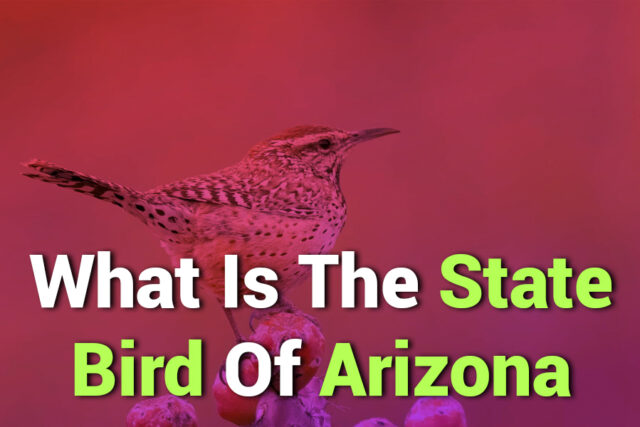What is the state bird of Arizona? It’s a question many may ask when exploring the natural wonders and wildlife of the Grand Canyon State. Arizona is a land of rugged deserts, towering cacti, and vibrant wildlife, and its state bird, the cactus wren, is a testament to this unique landscape. Known for its adaptability to arid conditions, the cactus wren symbolizes resilience and survival in a harsh desert climate.
This article will take you on a journey to understand why the cactus wren was chosen as the state bird of Arizona. We’ll discuss its characteristics, behavior, and importance in Arizona’s ecosystem and folklore. By the end, you’ll know not only what is the state bird of Arizona but also why it’s an iconic representation of the region.
What is the state bird of Arizona?
The state bird of Arizona is the cactus wren (Campylorhynchus brunneicapillus). It was officially designated in 1931. This bird thrives in the desert environment, often building nests in large cacti such as the saguaro. Recognized for its adaptability and resourcefulness, the cactus wren represents Arizona’s natural heritage. Its bold behavior, unique song, and ability to survive in arid conditions make it a fitting symbol for the state.
The Cactus Wren – Arizona’s State Bird
Arizona’s state bird is the cactus wren, an incredible species that thrives in the state’s harsh, arid desert regions. The cactus wren is easily recognizable due to its size, unique plumage, and loud, harsh call. It was named the state bird in 1931, reflecting its deep connection to Arizona’s desert ecosystems.
The cactus wren is larger than most other wrens, with a body length of around 7 to 9 inches. Its plumage is a blend of earthy brown with distinct white stripes over the eyes and speckled spots on its wings and chest. These markings provide natural camouflage, helping the bird blend into the desert landscape. Its large nests, often built within the protection of spiny cacti, serve as a defense against predators.
Adaptability is key to the cactus wren’s survival in Arizona’s dry climate. It feeds on insects, spiders, and fruits, rarely needing water since it derives most of its hydration from its diet. The bird’s relationship with cacti, particularly the saguaro and cholla, is essential to its way of life. Nests built inside these plants offer both shelter and safety from predators.
Culturally, the cactus wren is significant in Arizona. It symbolizes resilience and resourcefulness, qualities admired by residents who face the challenges of desert living. As part of Arizona’s desert biodiversity, the cactus wren also plays an essential role in controlling insect populations, contributing to the overall health of the ecosystem.
Physical and Behavioral Traits of the Cactus Wren
Appearance and Size
The cactus wren is the largest species of wren in the United States, measuring between 7 to 9 inches in length and boasting a wingspan of around 11 inches. Its distinctive plumage features a warm brown color with prominent white streaks running across its head and bold black speckling on its chest and body. This striking pattern helps the bird blend into its desert surroundings, providing natural camouflage. Its stout build and long tail are well-suited to navigating through the spiny terrain of its arid habitat.
Nesting Habits
Cactus wrens are skilled nest-builders, constructing large, dome-shaped nests from grasses and twigs. These nests are often nestled within the protective arms of saguaro or cholla cacti, which provide excellent shelter against predators. The dense, spiny surroundings deter threats like snakes and hawks, making cacti an ideal choice for nesting sites. These nests are not only used for raising young but may also serve as safe resting places throughout the year.
Diet and Feeding
Adapted to survive in harsh desert environments, the cactus wren has a diverse diet that primarily includes insects such as beetles, ants, and grasshoppers. It supplements this insect-based diet with fruits and seeds, particularly during times when prey is scarce. Interestingly, the cactus wren rarely needs direct access to water, as it obtains sufficient moisture from the food it consumes. This adaptation allows the bird to thrive in regions where water sources are limited.
Unique Behaviors
Known for its bold and curious nature, the cactus wren is highly territorial and protective of its nesting area. It aggressively defends its home from intruders, sometimes launching attacks on other birds that come too close. Another unique trait is its vocalization. The cactus wren produces a harsh, repetitive chattering song that establishes and maintains its territory. This call is a familiar sound in the deserts of the southwestern United States.
Habitat Range
The cactus wren inhabits the deserts of the southwestern United States, particularly Arizona, as well as parts of northern Mexico. It prefers arid landscapes rich in cacti and shrubs but has also adapted to human-altered environments, often appearing around residential areas. Despite the challenges of desert life, this adaptable bird continues to thrive, embodying the resilience and character of its harsh environment.
Why Was the Cactus Wren Chosen as Arizona’s State Bird?
The cactus wren was designated the state bird of Arizona due to its deep connection to the desert environment, cultural symbolism, and ecological significance. Here are the key reasons behind its designation:
- Desert Symbolism: The cactus wren is a living symbol of Arizona’s desert landscape. Its daily life revolves around the desert ecosystem, where it relies on cacti for nesting and adapting to arid conditions. By thriving in such an environment, the bird represents the state’s natural heritage.
- Adaptability: Surviving in Arizona’s extreme heat and dryness requires remarkable resilience. The cactus wren has adapted to these challenges by conserving water through its diet and seeking shelter within cactus plants. Its ability to flourish in such harsh conditions reflects the tenacity needed to thrive in the desert, making it a fitting emblem of survival in Arizona.
- Cultural Significance: For many residents of Arizona, the cactus wren symbolizes strength, independence, and perseverance. Its bold and fearless behavior, including the defense of its territory and nest, resonates with the spirit of those who call the desert home. Over time, this association has cemented the bird’s status as a cherished symbol of the state’s identity.
- Ecosystem Importance: The cactus wren plays a crucial role in maintaining the balance of desert ecosystems. By feeding on insects such as beetles and grasshoppers, the bird helps control pest populations that might otherwise harm native plants. Additionally, the presence of cactus wrens can indicate the overall health of the desert habitat, making them an important species for monitoring environmental stability.
These combined factors of ecological significance, adaptability, and cultural resonance highlight why the cactus wren was chosen as Arizona’s official state bird. Its presence serves as a reminder of the beauty and resilience found in the desert environment.
How Does the Cactus Wren Survive Arizona’s Extreme Climate?
Arizona’s desert climate poses significant challenges with its extreme heat and limited water availability. The cactus wren has developed various physical and behavioral adaptations to thrive in these harsh conditions.
- Water-Saving Diet: The cactus wren has adapted to survive without needing direct access to water. By consuming moisture-rich food sources such as insects and fruits, the bird obtains sufficient hydration. This diet helps minimize water loss, allowing it to flourish in arid environments where natural water sources are scarce.
- Protective Nesting Habits: Nesting is a crucial survival strategy for the cactus wren. It builds large, dome-shaped nests within the protective arms of cacti like the saguaro and cholla. These nests offer several advantages: the spines of the cacti deter predators such as snakes, and the structure provides shade to shield the bird from the scorching desert sun. This safe nesting environment is essential for the bird’s survival and reproduction.
- Behavioral Adaptations: To cope with intense heat, the cactus wren adjusts its daily activities. During the hottest part of the day, it seeks shade and reduces movement to conserve energy and prevent overheating. The bird is most active during the cooler hours of the morning and evening, taking advantage of lower temperatures to forage and defend its territory. This pattern of activity helps the cactus wren avoid heat stress.
- Resilience and Survival: The cactus wren’s ability to endure and adapt to extreme desert conditions demonstrates remarkable resilience. Its survival strategies have enabled it to thrive in an environment that is inhospitable to many other species. This resilience is one of the reasons it was designated Arizona’s state bird, serving as a symbol of the resourcefulness and strength needed to live in the desert.
Fascinating Facts About the State Bird of Arizona
What Makes the Cactus Wren Unique?
The cactus wren is the largest wren species in the United States. This physical feature, combined with its bold personality, sets it apart from other wrens. Another unique characteristic is its nesting behavior. Unlike many other birds that build a single nest per breeding season, the cactus wren constructs multiple nests throughout the year. Some nests are used for breeding, while others serve as shelters, protecting from predators and harsh desert conditions.
The cactus wren’s call is another defining trait. Its loud, repetitive chattering is often compared to a mechanical sound, making it a recognizable presence in the desert landscape. This vocalization is crucial for communication, particularly when defending its territory or signaling potential threats. Together, these attributes make the cactus wren a fascinating and adaptable desert dweller.
How Does It Interact with Other Desert Animals?
In the challenging environment of the desert, the cactus wren interacts with various other species in ways that help ensure its survival. One of its most important relationships is with the cacti where it nests. By building its nests high in the spiny arms of saguaro or cholla cacti, the bird benefits from natural protection against predators such as snakes and birds of prey. The dense, thorny surroundings make it difficult for predators to reach the nests, allowing the wren to safely raise their young.
However, life in the desert also involves competition. The cactus wren often compete with other birds for limited resources, including insects, seeds, and ideal nesting sites. This competition can sometimes lead to aggressive encounters as the wren defends its territory. Despite these challenges, the cactus wren’s resourcefulness and adaptability enable it to maintain a stable presence in its habitat.
What Is Its Conservation Status?
Although the cactus wren is not currently classified as endangered, it faces risks from habitat destruction and environmental changes. The expansion of urban areas, agricultural development, and the loss of native desert vegetation have all contributed to a decline in suitable habitats for the species. As a result, conservation efforts focus on preserving and restoring desert ecosystems to ensure the cactus wren and other native species can continue to thrive.
By maintaining healthy desert habitats, conservationists aim to protect not only the cactus wren but also the delicate balance of life that defines these arid regions.
Conclusion
The state bird of Arizona, the cactus wren, is a remarkable symbol of the desert’s resilience and beauty. Known for its adaptability, it thrives in harsh, arid conditions by conserving water through its diet and finding protection in cacti. Its bold nature and loud, mechanical call make it a distinctive presence in the desert landscape.
The cactus wren holds deep cultural significance, representing strength and survival to many Arizonans. Efforts to protect its habitat are crucial for preserving this unique species. If you’re wondering, “What is the state bird of Arizona?” the cactus wren stands as a proud answer.
FAQ’s
Q: What is the state bird of Arizona?
A: The cactus wren is Arizona’s state bird, known for its large size, bold behavior, and desert adaptations.
Q: When was the cactus wren chosen as the state bird?
A: It was officially named the state bird of Arizona in 1931.
Q: Why does the cactus wren build nests in cacti?
A: Nesting in cacti protects from predators and harsh environmental conditions.
Q: Where can I find cactus wrens in Arizona?
A: Cactus wrens are commonly found in desert areas, especially near saguaro and cholla cacti.
Q: What does the cactus wren eat?
A: It primarily eats insects, spiders, and fruits, deriving most of its water from food sources.














